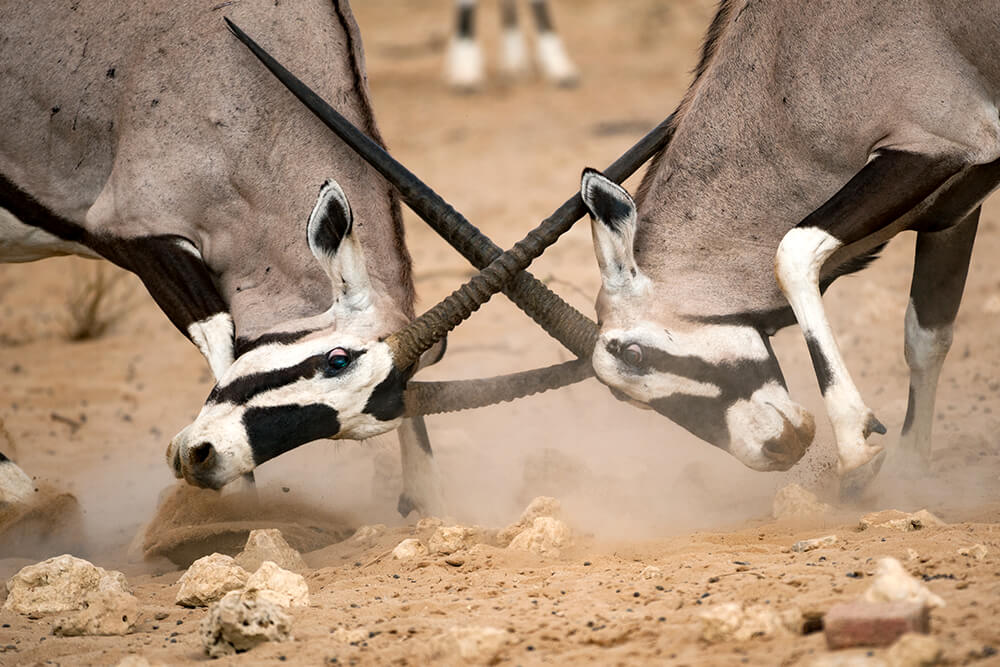Oryx
- CLASS: Mammalia (Mammals)
- ORDER: Artiodactyla
- FAMILY: Bovidae
- GENUS: Oryx
- SPECIES: six
ABOUT

Horns aplenty: Oryx are distinctive antelope with long, straight, slender horns. These horns, carried by both males and females, give oryx the nickname "spear antelope." The horns of the scimitar-horned oryx O. dammah are a bit different. This oryx gets its common name from the shape of its horns—long and curved like Arabian swords called scimitars. In all six oryx species, the horns of females are longer than those of males.
Oryx are often called gemsbok (pronounced JEMS baak) in Africa. But in Germany, gemsbok is the common name for the chamois, a type of goat-antelope! Having a scientific name as well as a common name helps people around the world know which animal they're talking about.
Oryx range in color from whitish to light brown or gray, depending on the species. They have much darker hair on the legs and in a stripe along the belly and back. Fringe-eared oryx also have black tufts of hair on their ear tips.
Oryx live in open areas of desert, semi-desert, dry grasslands, and scrublands. Some of these areas can get mighty hot! Not to worry, though. Oryx have an unusual circulation system in their head. They are able to cool the blood flowing to their brain through the capillaries in their nose as they breathe.
Beisa oryx O. beisa and fringe-eared oryx O. beisa callotis can tolerate periods of extreme heat by raising their body temperature to 116 degrees Fahrenheit (47 degrees Celsius). This causes heat to leave their body for the surrounding cooler air, rather than losing moisture through sweating or evaporation. When it gets too hot, and shade is not available, oryx dig shallow holes for resting and cooling down.

The Arabian oryx O. leucoryx is the most specialized oryx for living in true desert extremes. Its light color reflects the desert heat and sunlight, and it can erect its hair on cold winter mornings to capture warmth to hold in its thick undercoat. Arabian oryx legs also darken in the winter to absorb more of the sun's heat.
Those long oryx horns come in handy for protection from predators (lions, leopard, and hyenas). If threatened, oryx display a unique behavior: standing sideways to appear larger. If this fails to intimidate the enemy, they use their horns to defend or attack.

Adult male oryx sometimes fight for dominance in the herd. They may clash horns, butt heads, and push and shove, but they do not try to gore the opponent.
HABITAT AND DIET

It's hot here: Oryx live in desert, semi-desert, steppes, stony flats, thorn scrub, and savanna habitats. Their range includes eastern and southern Africa, Oman, United Arab Emirates, and Jordan (for Arabian oryx only).
Because of their dry habitat, food can be scarce for oryx. They move in small, mixed groups or large herds of up to 100 or more, searching for water and browsing or grazing on grasses and other vegetation. They may dig for tubers and roots. Oryx can form mega-herds of several hundred individuals when there are large areas of fresh vegetation.
Oryx are most active in the morning, and then again in the late afternoon and early evening. They spend the warm portions of the day standing or reclining in shaded areas. As ruminants, this gives them a chance to chew their cud and digest their food. The herds move to different areas as the seasons change. A female leads the herd in a single-file "march," but it is not always the same female. The dominant male is “tail-end Charlie.” If water is not available, oryx can survive from the moisture in the vegetation they eat or by licking dew off their coats or from rocks.
FAMILY LIFE

Oryx can breed at any time of the year. A female leaves the herd to give birth to one calf. The calf is born with small horns covered with hair. Like all ungulates, the youngster is able to get up and follow its mother when just a few hours old! A mother often hides her young for its first two to three weeks while she forages, before returning to the herd. The calf can feed on its own after about four months, staying with the parent herd but no longer remaining with its mother. Oryx reach maturity at one to two years old.
CONSERVATION
Scimitar-horned oryx O. dammah once ranged across North Africa. Now extinct in their native habitat, they currently live only in zoos. The good news is that there are several successful breeding herds in zoos. San Diego Zoo Wildlife Alliance has had over 500 scimitar-horned oryx births, a world record!
The Arabian oryx O. leucoryx was endangered. This antelope of the Arabian Peninsula and Sinai Desert became extinct in their native habitat by the 1960s, mostly due to hunters shooting them with high-powered rifles. To save the species, nine Arabian oryx from private collections in Oman, Kuwait, and Saudi Arabia, as well as from the London Zoo, were moved to the Phoenix Zoo in Arizona. These nine oryx became known as the World Herd. A second breeding group of three oryx, from a zoo in Saudi Arabia, was started at the Los Angeles Zoo.
By 2022, more than 370 Arabian oryx had been born at the Park! In one of the great conservation success stories, 73 Arabian oryx have been returned to Oman, the United Arab Emirates, and Jordan for reintroduction to protected areas in their native range. The species' status is now listed as Vulnerable, rather than Endangered, by the International Union for Conservation of Nature.
By supporting San Diego Zoo Wildlife Alliance, you are our ally in saving and protecting wildlife worldwide.










